#6 Six months after I saw “Superman”, “Alien” was released to the theaters in the summer of 1979. This is a movie I’ve re-watched more times than I can remember, in whole or in part. I remember years later reading about how Allen Daviau and Steven Spielberg watched “Alien”, among other movies, before beginning “E.T.”, and Spielberg said something to the effect that every lighting texture possible from the sharpest, hardest light to the softest was in “Alien”. I think this is a very astute observation; in fact, this is an entire movie about texture, not just in the lighting, but in every visual category. Even the sound effects and music are highly atmospheric and dimensional (the ripe melon sound of the Kane’s helmet being cracked open in the medical bay always gets me).
One scene I’ve rewatched many times is when Ripley has to activate the self-destruct mechanism. Every shot has some sort of textured surface in it, from the sweat glistening on her hands as she pulls down on the steel levels, the wet hatch popping up when beads of water running down it, the steel bolts she screws into console and that “schwoop” the brass cylinders make when Ripley extends them, etc. There is sweat, steam, smoke, water in various combinations in every shot. This movie, and “Blade Runner” as well, is a textbook on how to light and shoot inserts.
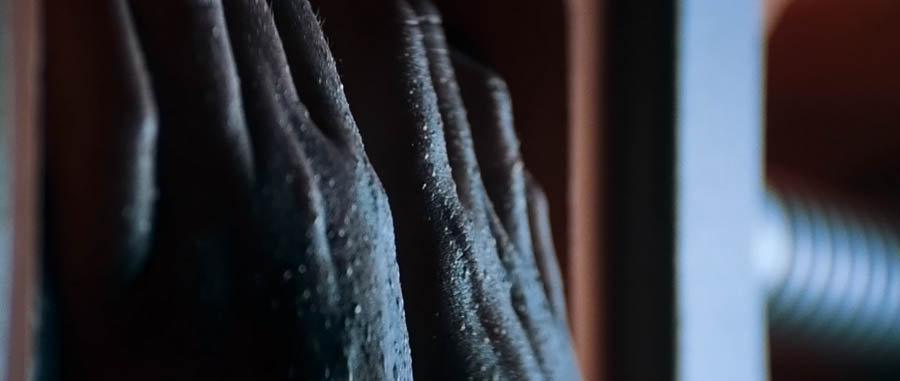
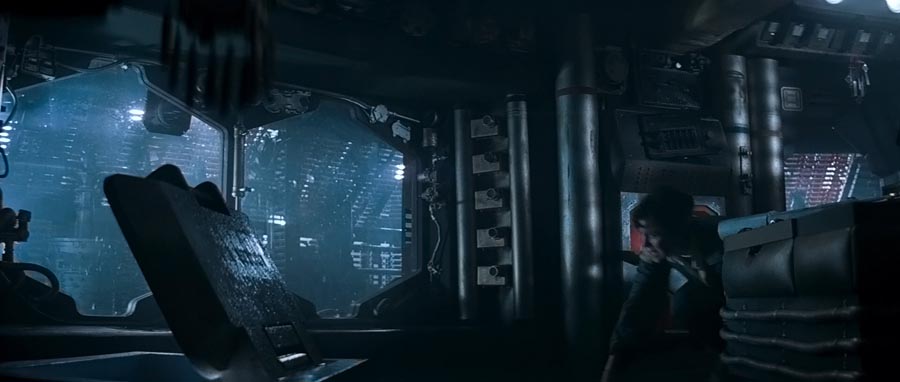
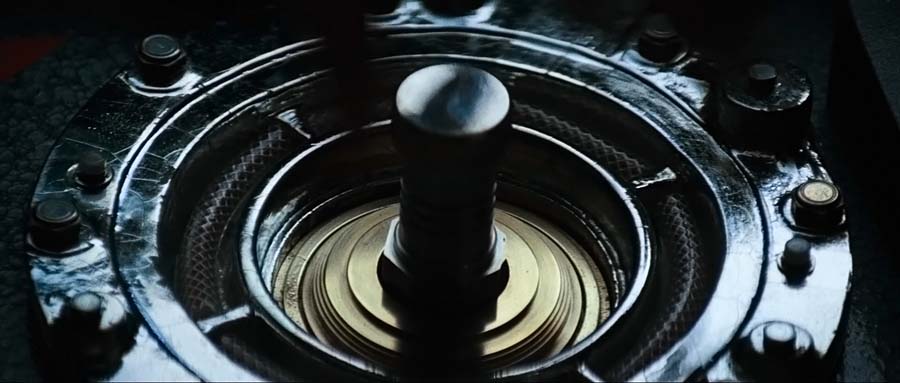
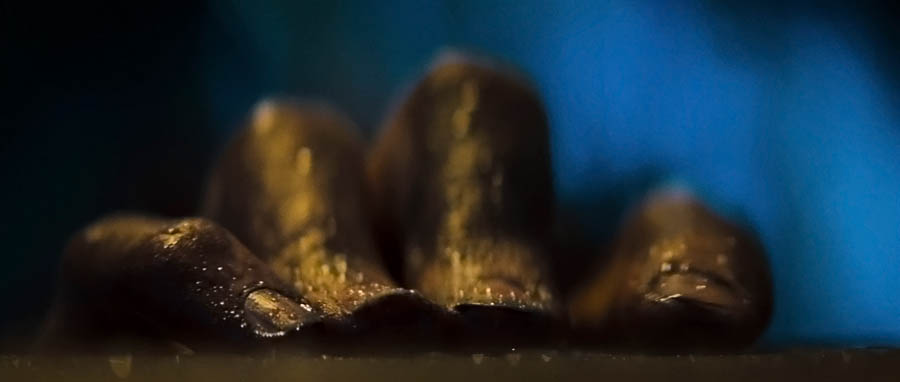
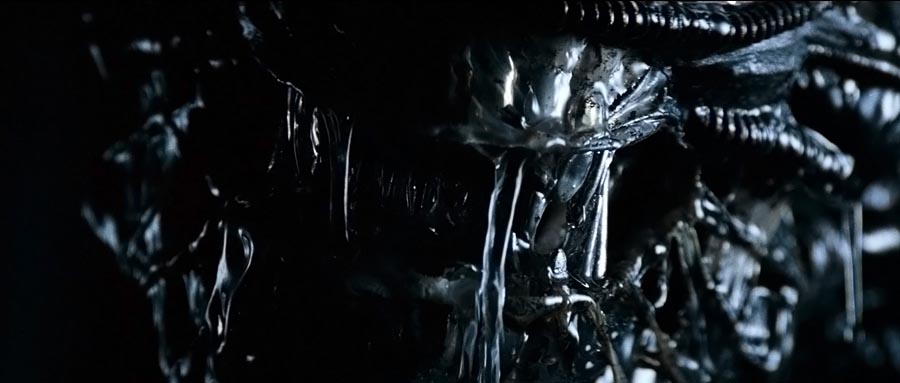
The sharp 35mm anamorphic photography, all on 125T 5247, made me think about the relative value of on-screen resolution. I’m not someone who believes that all movies need to be clean and sharp (clearly, considering my love of Geoffrey Unsworth’s fog-filtered work) but one thing that a detailed image on a big screen can do is convey the textures of a place – for example, the dirt, the dust, and the aging surfaces of old buildings. When I’m in discussions with a director about formats, I bring this issue up sometimes, whether the format we are discussing will effectively convey the textures of the story’s locations. Of course, contrast also affects apparent sharpness and where a high-resolution format helps is when you get into wide-open spaces with subtle textures (like an expanse of sand dunes) especially if the weather gets flat, whereas it might matter less in a constricted space with a lot of light and shadow creating contrast. Anyway, as is often said, sharpness is not always a cinematographer’s friend (especially for portraits) but sometimes it helps capture textural details that create the right mood for the story.
It’s too bad that Derek Vanlint didn’t shoot more features – a few years after “Alien”, he did “Dragonslayer”, which is also quite atmospheric at times.
It was studying this movie that I figured out a basic lighting principle, which could be described either as “when a face is lit in half with the key coming around just enough to light the second eye, put the camera on the shadow side of the face”. Or another way to think of it is “light from the direction that the actor’s eyes are pointing in terms of screen direction (if the actor is looking screen right, then the key should come from the right side of frame)”. Or “put the key light coming from upstage and the camera downstage”. It was studying this close-up of Ripley at the end of the movie that I figured this out.
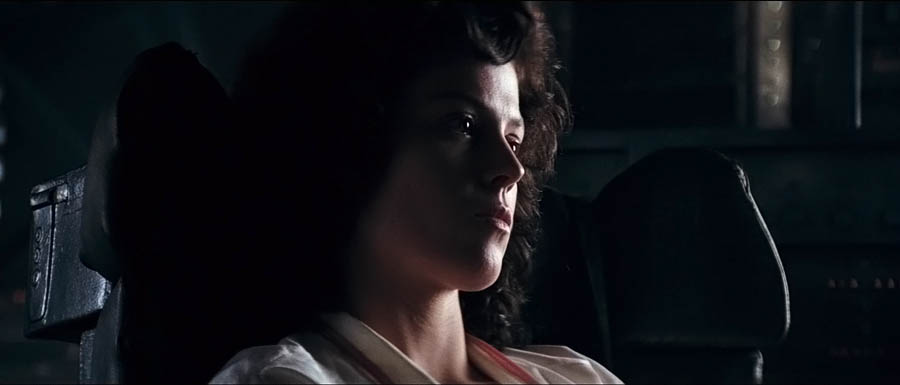
Copyright © CML. All rights reserved.
- aces.png
- aces.png
- aces.png
- aces.png
- 24-7.jpg
- 24-7.jpg
- arri.png
- arri.png
- BandH.jpg
- camalot.png
- camalot.png
- dedo.png
- dsc.png
- dsc.png
- kino.png
- Hawk.png
- JustCinemaGear.jpg
- Leitz_logo.png
- Leitz_logo.png
- Lowing.gif
- Module8Logo.png
- GodoxLogo.png
- Nanlux.png
- NPV_new_logo-(3)-(002).png
- NMBLogoForCML.png
- lindseyo.jpg
- Aputure.png
- TC Logo Centered K_2.png
- VMI.png
- zeiss-logo.png
- zeiss-logo.png
- aces.png
- aces.png
- aces.png
- aces.png
- 24-7.jpg
- 24-7.jpg
- arri.png
- arri.png
- BandH.jpg
- camalot.png
- camalot.png
- dedo.png
- dsc.png
- dsc.png
- FUJINON.jpg
- JustCinemaGear.jpg
- Leitz_logo.png
- Leitz_logo.png
- GodoxLogo.png
- Nanlux.png
- NPV_new_logo-(3)-(002).png
- NMBLogoForCML.png
- FilmLightLogo.png
- theKeep.png
- NewLifeCineLogo.png
- PostWorks.png
- Aputure.png
- TCS.png
- TC Logo Centered K_2.png
- zeiss-logo.png
- zeiss-logo.png
- aces.png
- aces.png
- aces.png
- aces.png
- 24-7.jpg
- 24-7.jpg
- arri.png
- arri.png
- BandH.jpg
- camalot.png
- camalot.png
- dedo.png
- dsc.png
- dsc.png
- kino.png
- Hawk.png
- JustCinemaGear.jpg
- Leitz_logo.png
- Leitz_logo.png
- Lowing.gif
- Module8Logo.png
- GodoxLogo.png
- Nanlux.png
- NPV_new_logo-(3)-(002).png
- NMBLogoForCML.png
- lindseyo.jpg
- Aputure.png
- TC Logo Centered K_2.png
- VMI.png
- zeiss-logo.png
- zeiss-logo.png
- aces.png
- aces.png
- aces.png
- aces.png
- 24-7.jpg
- 24-7.jpg
- arri.png
- arri.png
- BandH.jpg
- camalot.png
- camalot.png
- dedo.png
- dsc.png
- dsc.png
- FUJINON.jpg
- JustCinemaGear.jpg
- Leitz_logo.png
- Leitz_logo.png
- GodoxLogo.png
- Nanlux.png
- NPV_new_logo-(3)-(002).png
- NMBLogoForCML.png
- FilmLightLogo.png
- theKeep.png
- NewLifeCineLogo.png
- PostWorks.png
- Aputure.png
- TCS.png
- TC Logo Centered K_2.png
- zeiss-logo.png
- zeiss-logo.png
- aces.png
- aces.png
- aces.png
- aces.png
- 24-7.jpg
- 24-7.jpg
- arri.png
- arri.png
- BandH.jpg
- camalot.png
- camalot.png
- dedo.png
- dsc.png
- dsc.png
- kino.png
- Hawk.png
- JustCinemaGear.jpg
- Leitz_logo.png
- Leitz_logo.png
- Lowing.gif
- Module8Logo.png
- GodoxLogo.png
- Nanlux.png
- NPV_new_logo-(3)-(002).png
- NMBLogoForCML.png
- lindseyo.jpg
- Aputure.png
- TC Logo Centered K_2.png
- VMI.png
- zeiss-logo.png
- zeiss-logo.png
- aces.png
- aces.png
- aces.png
- aces.png
- 24-7.jpg
- 24-7.jpg
- arri.png
- arri.png
- BandH.jpg
- camalot.png
- camalot.png
- dedo.png
- dsc.png
- dsc.png
- FUJINON.jpg
- JustCinemaGear.jpg
- Leitz_logo.png
- Leitz_logo.png
- GodoxLogo.png
- Nanlux.png
- NPV_new_logo-(3)-(002).png
- NMBLogoForCML.png
- FilmLightLogo.png
- theKeep.png
- NewLifeCineLogo.png
- PostWorks.png
- Aputure.png
- TCS.png
- TC Logo Centered K_2.png
- zeiss-logo.png
- zeiss-logo.png
- aces.png
- aces.png
- aces.png
- aces.png
- 24-7.jpg
- 24-7.jpg
- arri.png
- arri.png
- BandH.jpg
- camalot.png
- camalot.png
- dedo.png
- dsc.png
- dsc.png
- kino.png
- Hawk.png
- JustCinemaGear.jpg
- Leitz_logo.png
- Leitz_logo.png
- Lowing.gif
- Module8Logo.png
- GodoxLogo.png
- Nanlux.png
- NPV_new_logo-(3)-(002).png
- NMBLogoForCML.png
- lindseyo.jpg
- Aputure.png
- TC Logo Centered K_2.png
- VMI.png
- zeiss-logo.png
- zeiss-logo.png
- aces.png
- aces.png
- aces.png
- aces.png
- 24-7.jpg
- 24-7.jpg
- arri.png
- arri.png
- BandH.jpg
- camalot.png
- camalot.png
- dedo.png
- dsc.png
- dsc.png
- FUJINON.jpg
- JustCinemaGear.jpg
- Leitz_logo.png
- Leitz_logo.png
- GodoxLogo.png
- Nanlux.png
- NPV_new_logo-(3)-(002).png
- NMBLogoForCML.png
- FilmLightLogo.png
- theKeep.png
- NewLifeCineLogo.png
- PostWorks.png
- Aputure.png
- TCS.png
- TC Logo Centered K_2.png
- zeiss-logo.png
- zeiss-logo.png


